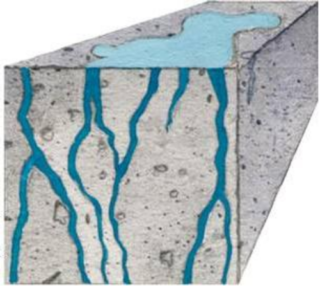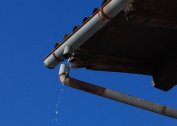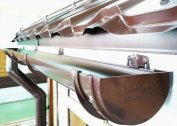Many people, even those far from the construction sector, are well aware that the construction of any structure consists of a foundation, walls and roof. The foundation plays a large role, since it is the quality of its manufacture that largely determines how much the house will stand idle and how reliable it will be. During operation, the foundation is subjected to various loads. In winter, it is affected by low temperatures, and in spring, when the ice begins to melt in the soil, it is affected by moisture. In addition, groundwater, which rises to the surface in spring, also affects it not in the best way. Therefore, in order for the foundation to serve for a long time, it is necessary to take care of its protection during the construction of the house.
Where to begin
 It should be noted that not only the foundation needs protection from moisture, but also the base, therefore, when work is underway on the construction of a country house, it is necessary already at the stage of foundation construction to think about its protection against moisture. When performing waterproofing, reliable protection should be provided from groundwater, as well as from moisture that seeps through the capillaries of the materials from which the foundation is made. If the groundwater in the area is located below the foundation plate, then in this case it is enough to carry out waterproofing works on the basement floor screed. In addition, measures must be taken to cover the concrete base of the house outside with heated bitumen.
It should be noted that not only the foundation needs protection from moisture, but also the base, therefore, when work is underway on the construction of a country house, it is necessary already at the stage of foundation construction to think about its protection against moisture. When performing waterproofing, reliable protection should be provided from groundwater, as well as from moisture that seeps through the capillaries of the materials from which the foundation is made. If the groundwater in the area is located below the foundation plate, then in this case it is enough to carry out waterproofing works on the basement floor screed. In addition, measures must be taken to cover the concrete base of the house outside with heated bitumen.
In some houses, the situation is such that the basement is located below the level at which groundwater lies. Here there is a need to create a waterproofing layer that does not have any gaps and is able to withstand severe groundwater pressure. When carrying out work on waterproofing the basement, the first important step that the owner of the building should take is to take the necessary measures aimed at lowering the groundwater level. To do this, earthworks are first carried out, at the end of which perforated pipes are placed in trenches around the entire perimeter of the house. With their help, water suitable for the house will be diverted to low places on the site. For example, natural ravines or organized gutters.
Clay castle
 Another important point that positively affects the high-quality waterproofing of the basement is the installation of a clay castle. This structure is a ditch, which is located around the foundation. When working on basement waterproofing, it is necessary to arrange a rough floor. Note that in its creation there are certain nuances. He falls asleep with clay, which is then rammed. The very same waterproofing layer in the basement is arranged as follows: first, the outer surface of the base of the house is processed, on which two materials are alternately applied. The first is hot bitumen, and the second is a layer of roofing material. The result is a kind of layer cake, which, nevertheless, provides reliable protection against moisture.
Another important point that positively affects the high-quality waterproofing of the basement is the installation of a clay castle. This structure is a ditch, which is located around the foundation. When working on basement waterproofing, it is necessary to arrange a rough floor. Note that in its creation there are certain nuances. He falls asleep with clay, which is then rammed. The very same waterproofing layer in the basement is arranged as follows: first, the outer surface of the base of the house is processed, on which two materials are alternately applied. The first is hot bitumen, and the second is a layer of roofing material. The result is a kind of layer cake, which, nevertheless, provides reliable protection against moisture.
We take into account the strength of concrete
When installing a concrete screed in the basement, it is necessary to make it so that it has good waterproofing properties. It must contain a water-repellent layer. At the same time, when preparing concrete for the screed itself, additives can be added to its composition, which will make the main material resistant to moisture. The inner surface of the wall in the basement also needs to be processed using special materials with waterproofing properties.When choosing the thickness of the impregnation, it is necessary to build on the hydraulic load on the structure. If the groundwater level in the area where the structure is located is quite high, then in this case the thickness of the flooring should be seriously increased. Thus, it is possible to compensate for the pressure of the increased water pressure.
 An important point is the protection of the walls of the building from such a load as capillary moisture. In order to cope with this problem, it is necessary to build a reliable barrier on the border of the base and the bottom of the wall. One of the modern solutions that can successfully cope with this problem is the spray-like application of a special coating with moisture-resistant properties based on polystyrene foam. Although this technology is relatively new, it is already in demand in the construction market.
An important point is the protection of the walls of the building from such a load as capillary moisture. In order to cope with this problem, it is necessary to build a reliable barrier on the border of the base and the bottom of the wall. One of the modern solutions that can successfully cope with this problem is the spray-like application of a special coating with moisture-resistant properties based on polystyrene foam. Although this technology is relatively new, it is already in demand in the construction market.
Competent work to protect the foundation against moisture ensures a good condition of the building structures and their long-term operation without losing their strength and other operational characteristics.


